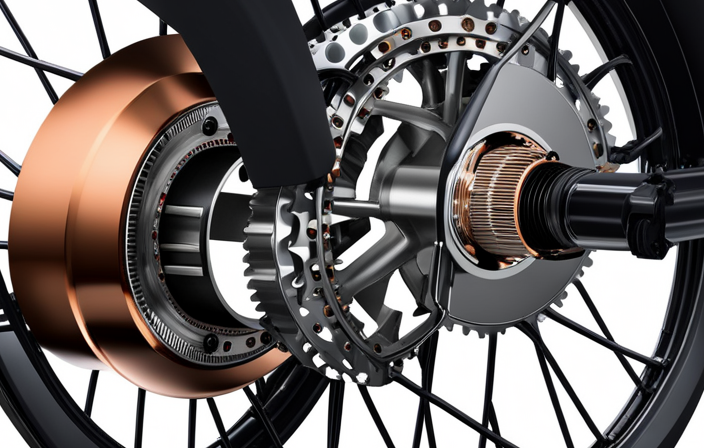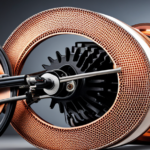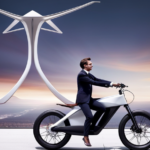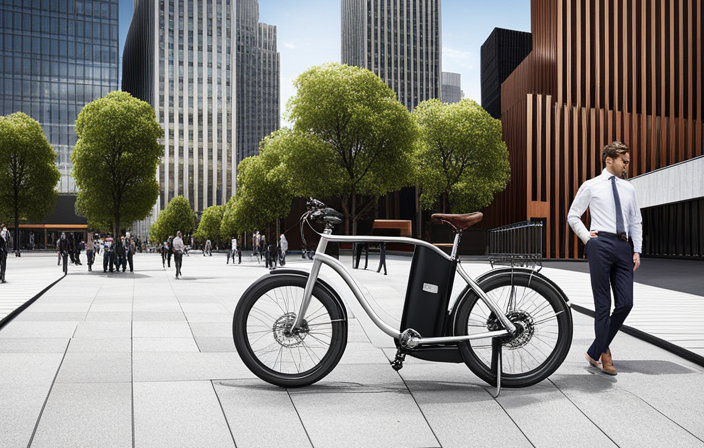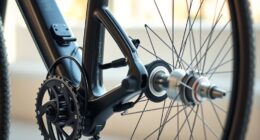As a cyclist, I have always been curious about the weight of electric bike motors. Therefore, I decided to explore the realm of electric bikes and uncovered some intriguing information.
Did you know that the average weight of electric bike motors ranges from 5 to 15 pounds? That’s a significant addition to the overall weight of the bike.
In this article, we’ll explore the various factors that affect motor weight, its impact on performance and battery life, and how to choose the right motor weight for your needs.
Let’s dive in and uncover the secrets of electric bike motor weight.
Key Takeaways
- Hub motors are simpler but less efficient than mid-drive motors.
- Motor weight affects rider comfort and handling capabilities.
- Mid-drive motors offer better efficiency, performance, and durability.
- Future trends aim for lighter motors without compromising power and agility.
Types of Electric Bike Motors
There are two main types of electric bike motors: hub motors and mid-drive motors.
Hub motors, as the name suggests, are located in the hub of either the front or rear wheel. They are known for their simplicity and ease of installation. However, they tend to be less efficient compared to mid-drive motors.
On the other hand, mid-drive motors are installed at the crankshaft of the bike, providing power directly to the pedals. This allows for better motor efficiency and improved performance, especially on hilly terrains. Additionally, mid-drive motors tend to be quieter compared to hub motors.
Understanding these differences in motor design and performance is crucial when considering factors affecting motor weight, such as battery capacity and frame material.
Factors Affecting Motor Weight
When it comes to electric bike motors, there are three key factors that affect their weight: power output, motor type, and battery size.
The power output of a motor determines how much force it can generate to propel the bike forward.
Different motor types, such as hub motors or mid-drive motors, have varying weights and performance characteristics.
Additionally, the size and capacity of the battery used to power the motor also play a role in determining the overall weight of the motor system.
Power Output
Electric bike motors typically have a power output ranging from 250 to 750 watts. This power output plays a crucial role in determining the overall performance of an electric bike. Here are some key points to consider regarding power output:
-
Power efficiency: Higher wattage motors generally offer better power efficiency, converting more electrical energy into mechanical power. This means the motor can deliver more power to the wheels, resulting in improved acceleration and performance.
-
Motor maintenance: The power output of an electric bike motor also affects its maintenance requirements. Higher wattage motors may generate more heat during operation, requiring regular maintenance to ensure optimal performance and longevity.
-
Range and battery life: The power output of the motor directly impacts the range and battery life of an electric bike. Higher wattage motors tend to consume more energy, which can reduce the overall range of the bike before requiring a recharge.
Considering these factors, it is crucial to select an electric bike motor with an appropriate power output that aligns with your performance needs and desired range.
Now, let’s delve into the next section about ‘motor type’ to understand its significance in electric bike motors.
Motor Type
One important factor to consider when choosing an electric bike is the type of motor it has. The motor plays a crucial role in determining the performance and efficiency of the bike.
Two main types of motors are commonly used in electric bikes: hub motors and mid-drive motors. Hub motors are typically located in the front or rear wheel and provide direct power to the wheel. They are known for their simplicity and low maintenance, but they may not offer the same level of efficiency as mid-drive motors.
On the other hand, mid-drive motors are situated near the bottom bracket and transfer power to the drivetrain. They are generally more efficient and offer better motor durability, making them ideal for hilly terrains and long-distance rides.
When considering motor efficiency and durability, it is important to weigh the pros and cons of each type to find the best fit for your needs.
Moving on to battery size…
Battery Size
To maximize your riding range and minimize the need for frequent recharging, it’s important to consider the size of your battery. The battery size of an electric bike is directly related to its battery life and energy consumption. Here are four key points to keep in mind:
-
Capacity: The capacity of a battery determines how much energy it can store. A higher capacity battery will generally provide a longer riding range.
-
Voltage: The voltage rating of a battery affects its power output. Higher voltage batteries can deliver more power to the motor, resulting in increased performance.
-
Chemistry: Different battery chemistries have varying energy densities and lifespans. Lithium-ion batteries are commonly used in electric bikes due to their high energy density and long lifespan.
-
Weight: Larger batteries tend to be heavier, which can impact the overall weight of the bike. It’s important to find a balance between battery size and weight to ensure optimal performance and handling.
Considering these factors will help you choose the right battery size for your electric bike, optimizing both battery life and energy consumption.
When it comes to electric bike motors, the average weight is another important consideration.
Average Weight of Electric Bike Motors
You might be surprised by how heavy electric bike motors can actually be. When it comes to choosing an electric bike, the weight of the motor is an important factor to consider. A heavier motor can have a significant impact on the maneuverability of the bike. To give you an idea of the motor weight comparison, take a look at the table below:
| Motor Brand | Motor Weight (lbs) |
|---|---|
| Brand A | 8 |
| Brand B | 10 |
| Brand C | 12 |
| Brand D | 15 |
As you can see, there can be a noticeable difference in weight between different motor brands. This weight discrepancy can affect how easily you can handle the bike, especially when navigating tight turns or steep inclines. In the next section, we will further explore the importance of motor weight for riders and how it can impact their overall riding experience.
Importance of Motor Weight for Riders
When considering the weight of a motor, it’s important to understand how it can impact your riding experience. The motor weight plays a crucial role in both rider comfort and handling capabilities. Here are three key ways motor weight can affect your electric bike:
-
Rider Comfort: A heavier motor can make the bike feel unbalanced, causing discomfort and fatigue during long rides. It can also increase the overall weight of the bike, making it harder to maneuver and control.
-
Handling Capabilities: The weight of the motor can affect the bike’s agility and responsiveness. A lighter motor allows for quicker acceleration, smoother cornering, and easier control, enhancing the overall riding experience.
-
Stability: A well-balanced motor weight helps maintain stability, especially at high speeds or on uneven terrain. This ensures a safer and more enjoyable ride.
Considering the impact of motor weight on rider comfort and handling capabilities, it’s essential to explore lightweight electric bike motors as a solution to optimize your riding experience.
Lightweight Electric Bike Motors
Lightweight motors significantly improve rider comfort and handling capabilities on electric bikes. When it comes to electric bike motors, weight plays a crucial role in determining the overall performance of the bike.
A lightweight motor provides several benefits for riders. Firstly, it enhances the maneuverability of the bike, allowing riders to navigate tight corners and turns with ease. Additionally, a lighter motor reduces the overall weight of the bike, making it easier to handle and control. This is especially important for riders who may struggle with lifting or maneuvering heavier electric bikes.
By reducing the motor weight, manufacturers can optimize the balance and weight distribution of the bike, resulting in improved stability and control. With these advantages, it’s clear why lightweight motors are highly valued by electric bike riders.
However, not all motors are lightweight, and the subsequent section will explore the impact of heavyweight electric bike motors.
Heavyweight Electric Bike Motors
To truly understand the drawbacks of heavyweight electric bike motors, it’s important to consider their impact on rider comfort and maneuverability. Heavyweight motors can significantly affect the overall performance of the bike, making it harder to handle and maneuver. Here are the key points to consider:
-
Decreased agility: The added weight of heavyweight motors makes it more challenging to navigate tight turns or maneuver through traffic, reducing the bike’s overall agility.
-
Reduced range: Heavy motors require more power to operate, resulting in decreased battery efficiency and reduced range. This can limit the distance a rider can travel before needing to recharge.
-
Increased fatigue: Maneuvering a bike with a heavy motor requires more physical effort, leading to increased rider fatigue and discomfort.
These factors highlight the importance of lightweight motor designs in preserving bike maneuverability and enhancing rider comfort. By reducing motor weight, manufacturers can create electric bikes that offer improved agility, increased range, and reduced rider fatigue.
This transition to the subsequent section about ‘motor weight and electric bike performance’ emphasizes the crucial role motor weight plays in determining the overall performance of electric bikes.
Motor Weight and Electric Bike Performance
If you want to enhance your electric bike’s performance, consider the impact of motor weight on factors like maneuverability and range. The weight of the motor plays a crucial role in determining how well your electric bike can handle hills and maintain its range. Heavier motors tend to have more power, which can be advantageous when climbing steep hills. However, this added weight can also make the bike less maneuverable and decrease its overall range. To give you a better understanding, let’s take a look at the table below:
| Motor Weight (lbs) | Hill Climbing Ability | Range |
|---|---|---|
| 10 | Moderate | 30 miles |
| 15 | Good | 25 miles |
| 20 | Excellent | 20 miles |
As you can see, as the motor weight increases, so does the hill climbing ability. However, there is a trade-off with the range. Therefore, it’s important to find the right balance between motor weight and overall performance.
Moving on to motor weight and battery life…
Motor Weight and Battery Life
When discussing the subtopic of energy efficiency and charging time in relation to electric bike motors, it is crucial to understand how these factors impact overall performance.
Energy efficiency refers to the ability of the motor to convert electrical energy into mechanical energy, and a higher efficiency rating means less energy is wasted during operation.
Additionally, charging time plays a significant role in the convenience and practicality of owning an electric bike, as shorter charging times allow for more frequent and efficient use of the vehicle.
Therefore, finding a balance between energy efficiency and charging time is essential for maximizing the benefits of electric bike motors.
Energy Efficiency
Electric bike motors are designed to be highly energy-efficient, making them a sustainable transportation option. The energy consumption of an electric bike motor depends on several factors such as motor efficiency, weight, and power output. Here are some key points to consider:
-
Motor Efficiency:
-
Electric bike motors are designed to convert a high percentage of electrical energy into mechanical energy, minimizing energy loss.
-
Brushless motors are commonly used in electric bikes due to their higher efficiency compared to brushed motors.
-
Regenerative braking systems can further improve motor efficiency by converting kinetic energy into electrical energy during braking.
-
Weight:
-
Lighter electric bike motors require less energy to operate, resulting in improved overall efficiency and longer battery life.
-
Manufacturers strive to reduce the weight of motors without compromising performance and durability.
-
Power Output:
-
Higher power output motors generally consume more energy, but they provide better acceleration and hill-climbing capabilities.
Considering the energy consumption and motor efficiency, it is essential to optimize these factors to maximize the range and overall efficiency of electric bikes.
Now, let’s delve into the next section about the charging time.
Charging Time
Transition: Now that we have explored the energy efficiency of electric bike motors, let’s delve into another important aspect of these motors: charging time. As a rider, it is crucial to understand how long it takes to charge your electric bike’s battery, especially when planning longer rides or commutes. The charging speed of an electric bike motor determines how quickly it can replenish its battery capacity. Typically, the charging time for electric bike batteries ranges from 3 to 8 hours, depending on the battery capacity and the charger’s power output. It is essential to note that the charging speed can vary based on the battery chemistry and the charger’s specifications. However, it is important to strike a balance between faster charging speeds and the impact it may have on battery life. Now, let’s move on to exploring how to choose the right motor weight for your needs.
| Charging Speed | Battery Life Impact |
|---|---|
| Fast | Moderate |
| Moderate | Low |
| Slow | None |
Transition: Now let’s move on to exploring how to choose the right motor weight for your needs.
How to Choose the Right Motor Weight for Your Needs
To choose the right motor weight for your needs, it’s important to consider factors such as your riding style and terrain. The weight of an electric bike motor can have a significant impact on its performance. Here are some key points to consider when choosing motor weight:
- Power delivery: A heavier motor can provide more torque, allowing for better acceleration and climbing ability.
- Maneuverability: A lighter motor can make the bike more agile and easier to handle, especially in tight corners or when navigating through traffic.
The impact of motor weight on performance is a delicate balance between power and agility. A heavier motor may offer more power, but it can also make the bike less maneuverable. On the other hand, a lighter motor may sacrifice some power, but it can enhance the bike’s handling and responsiveness.
As technology advances, future trends in electric bike motor weight will likely focus on finding the optimal balance between power and weight. Manufacturers will strive to develop lighter motors without compromising performance, allowing riders to enjoy the benefits of both power and maneuverability.
Future Trends in Electric Bike Motor Weight
When considering future trends in motor weight, you’ll want to look for advancements that prioritize a balance between power and agility. As technology continues to evolve, electric bike motors are becoming lighter and more compact, allowing for greater efficiency and performance.
These future advancements in motor weight have a significant impact on bike design, as manufacturers strive to create sleeker, more aerodynamic frames to complement the lighter motors. Additionally, advancements in battery technology play a crucial role in reducing overall weight, as lighter batteries contribute to a more agile ride.
The combination of lightweight motors and batteries not only improves the bike’s handling but also allows for longer rides without compromising power. As electric bike technology continues to advance, we can expect to see even lighter motors and batteries, resulting in bikes that offer the perfect balance of power and agility.
Frequently Asked Questions
Can the weight of an electric bike motor affect the overall weight distribution of the bike?
Yes, the weight of an electric bike motor can affect the overall weight distribution of the bike, which in turn impacts battery life and performance on different terrains.
Are there any safety concerns related to the weight of electric bike motors?
Safety concerns related to the weight of electric bike motors include compromised stability and maneuverability, especially during turns or at high speeds. Additionally, improper weight distribution can lead to increased strain on the frame and components, potentially causing structural damage.
Are there any specific regulations or restrictions regarding the weight of electric bike motors?
There are no specific regulations or restrictions regarding the weight of electric bike motors. However, the weight of the motor can impact its efficiency by affecting the overall performance and power consumption. Additionally, a heavier motor may reduce the battery range of an electric bike.
Can the weight of an electric bike motor affect the handling and maneuverability of the bike?
The weight of an electric bike motor can significantly impact the bike’s handling and maneuverability. It affects performance, making the bike feel sluggish or nimble. Design considerations must balance motor weight with other factors to optimize the overall riding experience.
Do lightweight electric bike motors offer any advantages over heavyweight motors, other than reduced weight?
Lightweight electric bike motors offer several advantages over heavyweight motors, apart from reduced weight. They enhance bike handling and maneuverability, improve acceleration and efficiency, and allow for easier installation and maintenance.
Conclusion
In conclusion, finding the right motor weight for your electric bike is crucial to ensure optimal performance and battery life.
While the weight of electric bike motors can vary depending on factors such as motor type and power output, it is important to consider the impact it can have on your riding experience.
Choosing a lightweight motor can enhance maneuverability and efficiency, while still providing sufficient power.
As future trends continue to focus on reducing motor weight, riders can expect even more advancements in electric bike technology.
